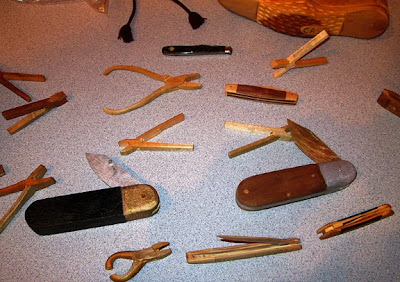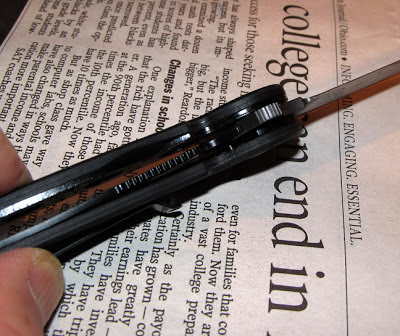Most of us are familiar with the Hubertus lever lock automatic knife. I own several, and I think they have great quality and style.
 |
| Hubertus Lever Lock Total icey! |
It’s a company with a complicated
history. Why complicated? WWII in Germany threw a lot of companies into
the dumpster of history. Some survived
and had Nazi associations which still haunts them to this day. Ask Degussa, now Evonik, about that.
On March 1, 1932, Kuno Ritter started a
knife company in Solingen, Germany, and concentrated on fixed blades called
hiking knives. We might call them
camping or bush craft knives.
Due to the Second World War, business
operations were discontinued in 1941 but resumed in 1946. I found a report claiming Kino Ritter Co.
made Boy Scout knives during the war. I
also saw reports that German Boy Scouting was closed and their members had to
join the Hitler Youth organizations.
Draw your own conclusion.
Following the war, Kuno Ritter Co acquired
several trademarks, including Hubertus, a brand registered for cutlery since
1899. For those wondering, Hubertus is
the patron saint of hunters.
An unknown Solinger cutler received a utility
pattern in 1897 for a folding lever release, making the knife safer to carry in
your pocket. We call it a lever lock.
Around 1950, the company was renamed Hubertus
Schneidwarenfabrik Kuno Ritter KG and is now run by the third-generation Ritter.
The Hubertus I recently ran across was a
Western Reserve Cutlery Association (WRCA) club knife. The date etched into the blade is 1985. This appears to be part of the Golden Era of
WRCA club knives when style and uniqueness trumped price.
 |
| WRCA's 1985 Club Knife |
The bolster has tiny numbers stamped into it, indicating it was 7 of 65 knives ordered. The top edge of the blade has some simple but nice file work, and the blade is etched. WRCA can be seen in the middle of the blade. The knife shows minor wear, but it is almost 40 years old.
I’m told this knife was offered to WRCA club
members in three different styles. One
was gold-filled, and the other was silver-filled, but my source couldn’t recall
the third option. I suspect it was just
the plain etched.
 |
| The stag looks a little worn and I like the file work on the blade spine |
To my surprise, the knife was ordered from
Hubertus factory and then etched. The
etching was done by Shaw Leibowitz. I
dug into the name and found out our master etcher was really a husband-and-wife
team composed of Sherill Shaw and Leonard Leibowitz. You can find an interesting article about
them by Bill Karsten in the December 1981 issue of Knife World and a better
article by Sherrill Shaw in its Sept 2011 issue. Knife World is now known as Knife Magazine,
an excellent publication for any knife fancier.
 |
| Hubertus from 1985 direct to WRCA |
I discussed the price with the owner but decided
not to purchase it. I'm not terribly
interested in club knives. https://knifesearch.blogspot.com/2023/03/not-huge-fan-of-club-knives.html It has to be really special. Plus, it is
my opinion, shared by several dealers, that club knives don't hold their
value. That's sad, but it is the way it
is.
My Thanks to Ian for lending me the knife for some quick photos!












